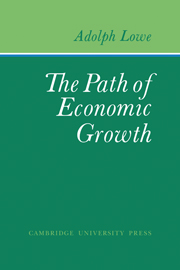Book contents
- Frontmatter
- Contents
- Preface
- Acknowledgments
- PART I The Basic Model
- PART II Changes in the Rate of Change
- PART III Changes in the Rate of Change
- PART IV Changes in the Rate of Change
- 21 The Scope of the Investigation
- 22 Dynamic Equilibrium Once More
- 23 Nonneutral Innovations: A General Survey
- 24 Pure Labor-Displacing Innovations
- 25 Pure Capital-Displacing Innovations
- 26 Some Comments on Combined Changes in the Input of Labor and Capital
- 27 Technical Progress and Diminishing Returns
- 28 Some Concluding Remarks
- Appendix: An Alternative Presentation of Lowe's Basic Model
- Glossary of Recurring Symbols
- Name Index
- Subject Index
22 - Dynamic Equilibrium Once More
Published online by Cambridge University Press: 07 October 2011
- Frontmatter
- Contents
- Preface
- Acknowledgments
- PART I The Basic Model
- PART II Changes in the Rate of Change
- PART III Changes in the Rate of Change
- PART IV Changes in the Rate of Change
- 21 The Scope of the Investigation
- 22 Dynamic Equilibrium Once More
- 23 Nonneutral Innovations: A General Survey
- 24 Pure Labor-Displacing Innovations
- 25 Pure Capital-Displacing Innovations
- 26 Some Comments on Combined Changes in the Input of Labor and Capital
- 27 Technical Progress and Diminishing Returns
- 28 Some Concluding Remarks
- Appendix: An Alternative Presentation of Lowe's Basic Model
- Glossary of Recurring Symbols
- Name Index
- Subject Index
Summary
In agreement with prevailing opinion we have so far defined dynamic equilibrium as an economic process moving under the impact of two steady growth stimuli, more specificially of a constant rate of growth of labor supply and of capital-requiring neutral innovations. Although we discovered that the conditions for the maintenance of dynamic equilibrium are stricter and its stability is firmer than the conventional interpretation of the Harrod-Domar formula contends, the basic validity of the formula itself was not questioned. In particular, it has been taken for granted that the procedure for providing the additional real capital required for the absorption of a labor increment is equally applicable to the provision of the capital in which the innovational change is to be embodied. This procedure consists, as we saw, in a reorganization of the stationary structure of production by shifting resources from the consumer-good sector to the equipment-good sectors. Such a shift is supposed to yield in each period of production a surplus of equipment goods in proportion with the combined period addition to labor supply and to technical productivity.
This notion that the steady expansion of the capital stock can be achieved by the steady addition of the period net output in the equipment-good sectors needs to be subjected to closer scrutiny. The procedure is unassailable so far as the steady absorption of a labor increment is concerned. In this case, homogeneous units of labor (homogeneous among themselves as well as with the preexisting stock of labor) are supposed to enter the system in a steady flow.
- Type
- Chapter
- Information
- The Path of Economic Growth , pp. 240 - 245Publisher: Cambridge University PressPrint publication year: 1976



